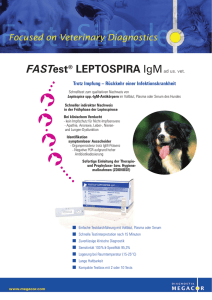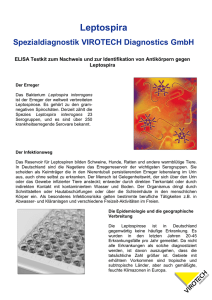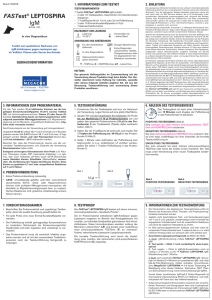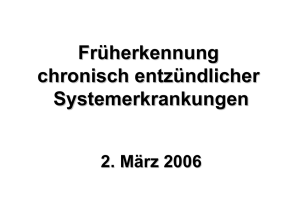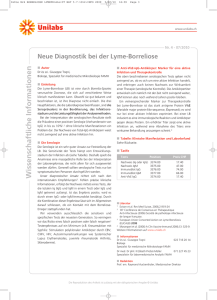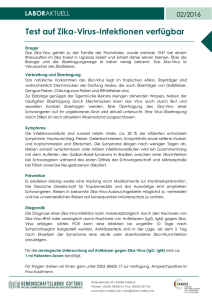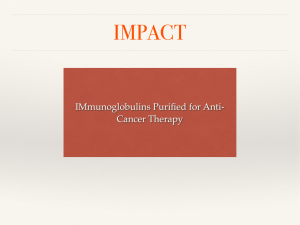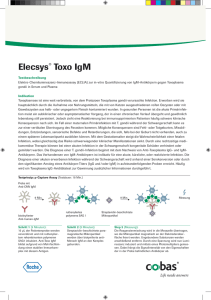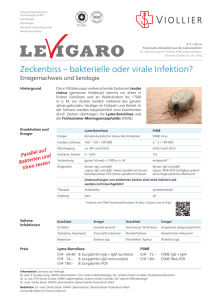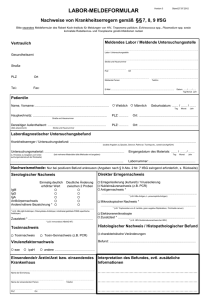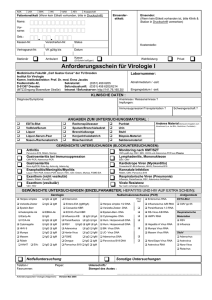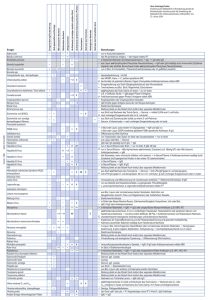FASTest® LEPTOSPIRA IgM - MEGACOR Diagnostik GmbH
Werbung
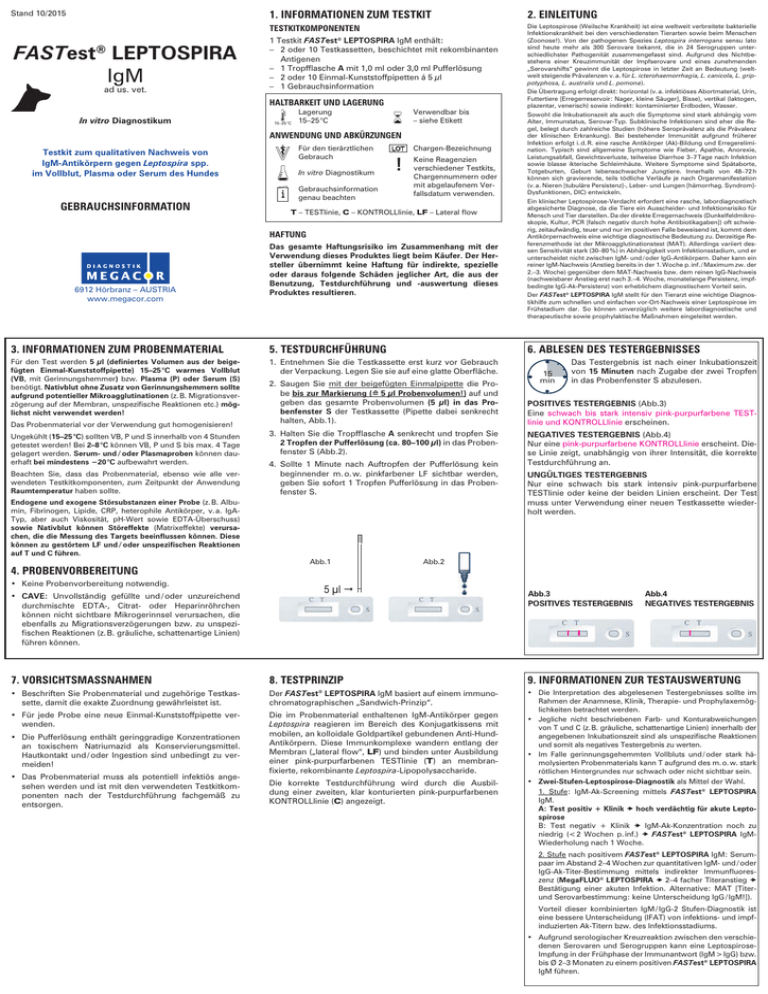
Stand 10/2015 FASTest® LEPTOSPIRA IgM ad us. vet. 1. INFORMATIONEN ZUM TESTKIT 2. EINLEITUNG TESTKITKOMPONENTEN Die Leptospirose (Weilsche Krankheit) ist eine weltweit verbreitete bakterielle Infektionskrankheit bei den verschiedensten Tierarten sowie beim Menschen (Zoonose!). Von der pathogenen Spezies Leptospira interrogans sensu lato sind heute mehr als 300 Serovare bekannt, die in 24 Serogruppen unterschiedlichster Pathogenität zusammengefasst sind. Aufgrund des Nichtbestehens einer Kreuzimmunität der Impfserovare und eines zunehmenden „Serovarshifts“ gewinnt die Leptospirose in letzter Zeit an Bedeutung (weltweit steigende Prävalenzen v. a. für L. icterohaemorrhagia, L. canicola, L. grippotyphosa, L. australis und L. pomona). Die Übertragung erfolgt direkt: horizontal (v. a. infektiöses Abortmaterial, Urin, Futtertiere [Erregerreservoir: Nager, kleine Säuger], Bisse), vertikal (laktogen, plazentar, venerisch) sowie indirekt: kontaminierter Erdboden, Wasser. Sowohl die Inkubationszeit als auch die Symptome sind stark abhängig vom Alter, Immunstatus, Serovar-Typ. Subklinische Infektionen sind eher die Regel, belegt durch zahlreiche Studien (höhere Seroprävalenz als die Prävalenz der klinischen Erkrankung). Bei bestehender Immunität aufgrund früherer Infektion erfolgt i. d. R. eine rasche Antikörper (Ak)-Bildung und Erregerelimination. Typisch sind allgemeine Symptome wie Fieber, Apathie, Anorexie, Leistungsabfall, Gewichtsverluste, teilweise Diarrhoe 3–7 Tage nach Infektion sowie blasse ikterische Schleimhäute. Weitere Symptome sind Spätaborte, Totgeburten, Geburt lebensschwacher Jungtiere. Innerhalb von 48–72 h können sich gravierende, teils tödliche Verläufe je nach Organmanifestation (v. a. Nieren [tubuläre Persistenz]-, Leber- und Lungen [hämorrhag. Syndrom]Dysfunktionen, DIC) entwickeln. Ein klinischer Leptospirose-Verdacht erfordert eine rasche, labordiagnostisch abgesicherte Diagnose, da die Tiere ein Ausscheider- und Infektionsrisiko für Mensch und Tier darstellen. Da der direkte Erregernachweis (Dunkelfeldmikroskopie, Kultur, PCR [falsch negativ durch hohe Antibiotikagaben]) oft schwierig, zeitaufwändig, teuer und nur im positiven Falle beweisend ist, kommt dem Antikörpernachweis eine wichtige diagnostische Bedeutung zu. Derzeitige Referenzmethode ist der Mikroagglutinationstest (MAT). Allerdings variiert dessen Sensitivität stark (30–80 %) in Abhängigkeit vom Infektionsstadium, und er unterscheidet nicht zwischen IgM- und / oder IgG-Antikörpern. Daher kann ein reiner IgM-Nachweis (Anstieg bereits in der 1. Woche p. inf. / Maximum zw. der 2.–3. Woche) gegenüber dem MAT-Nachweis bzw. dem reinen IgG-Nachweis (nachweisbarer Anstieg erst nach 3.–4. Woche, monatelange Persistenz, impfbedingte IgG-Ak-Persistenz) von erheblichem diagnostischem Vorteil sein. Der FASTest® LEPTOSPIRA IgM stellt für den Tierarzt eine wichtige Diagnostikhilfe zum schnellen und einfachen vor-Ort-Nachweis einer Leptospirose im Frühstadium dar. So können unverzüglich weitere labordiagnostische und therapeutische sowie prophylaktische Maßnahmen eingeleitet werden. 1 Testkit FASTest® LEPTOSPIRA IgM enthält: – 2 oder 10 Testkassetten, beschichtet mit rekombinanten Antigenen – 1 Tropfflasche A mit 1,0 ml oder 3,0 ml Pufferlösung – 2 oder 10 Einmal-Kunststoffpipetten á 5 µl – 1 Gebrauchsinformation HALTBARKEIT UND LAGERUNG In vitro Diagnostikum 15–25 °C Verwendbar bis – siehe Etikett Lagerung 15–25 °C ANWENDUNG UND ABKÜRZUNGEN Testkit zum qualitativen Nachweis von IgM-Antikörpern gegen Leptospira spp. im Vollblut, Plasma oder Serum des Hundes GEBRAUCHSINFORMATION Für den tierärztlichen Gebrauch In vitro Diagnostikum Gebrauchsinformation genau beachten LOT ! Chargen-Bezeichnung Keine Reagenzien verschiedener Testkits, Chargennummern oder mit abgelaufenem Verfallsdatum verwenden. T – TESTlinie, C – KONTROLLlinie, LF – Lateral flow HAFTUNG 6912 Hörbranz – AUSTRIA www.megacor.com Das gesamte Haftungsrisiko im Zusammenhang mit der Verwendung dieses Produktes liegt beim Käufer. Der Hersteller übernimmt keine Haftung für indirekte, spezielle oder daraus folgende Schäden jeglicher Art, die aus der Benutzung, Testdurchführung und -auswertung dieses Produktes resultieren. 6. ABLESEN DES TESTERGEBNISSES 3. INFORMATIONEN ZUM PROBENMATERIAL 5. TESTDURCHFÜHRUNG Für den Test werden 5 µl (definiertes Volumen aus der beigefügten Einmal-Kunststoffpipette) 15–25 °C warmes Vollblut (VB, mit Gerinnungshemmer) bzw. Plasma (P) oder Serum (S) benötigt. Nativblut ohne Zusatz von Gerinnungshemmern sollte aufgrund potentieller Mikroagglutinationen (z. B. Migrationsverzögerung auf der Membran, unspezifische Reaktionen etc.) möglichst nicht verwendet werden! 1. Entnehmen Sie die Testkassette erst kurz vor Gebrauch der Verpackung. Legen Sie sie auf eine glatte Oberfläche. Das Probenmaterial vor der Verwendung gut homogenisieren! Ungekühlt (15–25 °C) sollten VB, P und S innerhalb von 4 Stunden getestet werden! Bei 2–8 °C können VB, P und S bis max. 4 Tage gelagert werden. Serum- und / oder Plasmaproben können dauerhaft bei mindestens −20 °C aufbewahrt werden. Beachten Sie, dass das Probenmaterial, ebenso wie alle verwendeten Testkitkomponenten, zum Zeitpunkt der Anwendung Raumtemperatur haben sollte. 2. Saugen Sie mit der beigefügten Einmalpipette die Probe bis zur Markierung (= ^ 5 µl Probenvolumen!) auf und geben das gesamte Probenvolumen (5 µl) in das Probenfenster S der Testkassette (Pipette dabei senkrecht halten, Abb.1). 3. Halten Sie die Tropfflasche A senkrecht und tropfen Sie 2 Tropfen der Pufferlösung (ca. 80–100 µl) in das Probenfenster S (Abb.2). 4. Sollte 1 Minute nach Auftropfen der Pufferlösung kein beginnender m. o. w. pinkfarbener LF sichtbar werden, geben Sie sofort 1 Tropfen Pufferlösung in das Probenfenster S. Endogene und exogene Störsubstanzen einer Probe (z. B. Albumin, Fibrinogen, Lipide, CRP, heterophile Antikörper, v. a. IgATyp, aber auch Viskosität, pH-Wert sowie EDTA-Überschuss) sowie Nativblut können Störeffekte (Matrixeffekte) verursachen, die die Messung des Targets beeinflussen können. Diese können zu gestörtem LF und / oder unspezifischen Reaktionen auf T und C führen. 4. PROBENVORBEREITUNG • Keine Probenvorbereitung notwendig. • CAVE: Unvollständig gefüllte und / oder unzureichend durchmischte EDTA-, Citrat- oder Heparinröhrchen können nicht sichtbare Mikrogerinnsel verursachen, die ebenfalls zu Migrationsverzögerungen bzw. zu unspezifischen Reaktionen (z. B. gräuliche, schattenartige Linien) führen können. Abb.1 15 min Das Testergebnis ist nach einer Inkubationszeit von 15 Minuten nach Zugabe der zwei Tropfen in das Probenfenster S abzulesen. POSITIVES TESTERGEBNIS (Abb.3) Eine schwach bis stark intensiv pink-purpurfarbene TESTlinie und KONTROLLlinie erscheinen. NEGATIVES TESTERGEBNIS (Abb.4) Nur eine pink-purpurfarbene KONTROLLlinie erscheint. Diese Linie zeigt, unabhängig von ihrer Intensität, die korrekte Testdurchführung an. UNGÜLTIGES TESTERGEBNIS Nur eine schwach bis stark intensiv pink-purpurfarbene TESTlinie oder keine der beiden Linien erscheint. Der Test muss unter Verwendung einer neuen Testkassette wiederholt werden. Abb.2 5 μl Abb.3 POSITIVES TESTERGEBNIS Abb.4 NEGATIVES TESTERGEBNIS 7. VORSICHTSMASSNAHMEN 8. TESTPRINZIP 9. INFORMATIONEN ZUR TESTAUSWERTUNG • Beschriften Sie Probenmaterial und zugehörige Testkassette, damit die exakte Zuordnung gewährleistet ist. Der FASTest® LEPTOSPIRA IgM basiert auf einem immunochromatographischen „Sandwich-Prinzip“. • Für jede Probe eine neue Einmal-Kunststoffpipette verwenden. Die im Probenmaterial enthaltenen IgM-Antikörper gegen Leptospira reagieren im Bereich des Konjugatkissens mit mobilen, an kolloidale Goldpartikel gebundenen Anti-HundAntikörpern. Diese Immunkomplexe wandern entlang der Membran („lateral flow“, LF) und binden unter Ausbildung einer pink-purpurfarbenen TESTlinie (T) an membranfixierte, rekombinante Leptospira-Lipopolysaccharide. • Die Interpretation des abgelesenen Testergebnisses sollte im Rahmen der Anamnese, Klinik, Therapie- und Prophylaxemöglichkeiten betrachtet werden. • Jegliche nicht beschriebenen Farb- und Konturabweichungen von T und C (z. B. gräuliche, schattenartige Linien) innerhalb der angegebenen Inkubationszeit sind als unspezifische Reaktionen und somit als negatives Testergebnis zu werten. • Im Falle gerinnungsgehemmten Vollbluts und / oder stark hämolysierten Probenmaterials kann T aufgrund des m. o. w. stark rötlichen Hintergrundes nur schwach oder nicht sichtbar sein. • Zwei-Stufen-Leptospirose-Diagnostik als Mittel der Wahl. 1. Stufe: IgM-Ak-Screening mittels FASTest® LEPTOSPIRA IgM. A: Test positiv + Klinik hoch verdächtig für akute Leptospirose B: Test negativ + Klinik IgM-Ak-Konzentration noch zu niedrig (< 2 Wochen p. inf.) FASTest® LEPTOSPIRA IgMWiederholung nach 1 Woche. • Die Pufferlösung enthält geringgradige Konzentrationen an toxischem Natriumazid als Konservierungsmittel. Hautkontakt und / oder Ingestion sind unbedingt zu vermeiden! • Das Probenmaterial muss als potentiell infektiös angesehen werden und ist mit den verwendeten Testkitkomponenten nach der Testdurchführung fachgemäß zu entsorgen. Die korrekte Testdurchführung wird durch die Ausbildung einer zweiten, klar konturierten pink-purpurfarbenen KONTROLLlinie (C) angezeigt. 2. Stufe nach positivem FASTest® LEPTOSPIRA IgM: Serumpaar im Abstand 2–4 Wochen zur quantitativen IgM- und / oder IgG-Ak-Titer-Bestimmung mittels indirekter Immunfluoreszenz (MegaFLUO® LEPTOSPIRA 2–4 facher Titeranstieg Bestätigung einer akuten Infektion. Alternative: MAT [Titerund Serovarbestimmung: keine Unterscheidung IgG / IgM!]). Vorteil dieser kombinierten IgM / IgG-2 Stufen-Diagnostik ist eine bessere Unterscheidung (IFAT) von infektions- und impfinduzierten Ak-Titern bzw. des Infektionsstadiums. • Aufgrund serologischer Kreuzreaktion zwischen den verschiedenen Serovaren und Serogruppen kann eine LeptospiroseImpfung in der Frühphase der Immunantwort (IgM > IgG) bzw. bis Ø 2–3 Monaten zu einem positiven FASTest® LEPTOSPIRA IgM führen. Version 10/2015 FASTest® LEPTOSPIRA IgM ad us. vet. In vitro diagnosticum Test-kit for the qualitative detection of IgM antibodies against Leptospira spp. in whole blood, plasma or serum of the dog INSTRUCTIONS FOR USE 1. INFORMATION ON THE TEST-KIT 2. INTRODUCTION TEST-KIT COMPONENTS Leptospirosis (Weil’s disease) is a world-wide spread bacterial infectious disease in various animals and humans (zoonosis!). Of the pathogen species Leptospira interrogans sensu lato, more than 300 serovars are known which are summarised in 24 serogroups of varying pathogenicity. Due to nonexistence of a cross immunity of the vaccination serovars and an increasing “serovar shift”, leptospirosis becomes more important (world-wide increasing prevalences especially for L. icterohaemorrhagia, L. canicola, L. grippotyphosa, L. australis and L. pomona). 1 test-kit FASTest® LEPTOSPIRA IgM contains: – 2 or 10 test cassettes coated with recombinant antigens – 1 dropper bottle A with 1.0 ml or 3.0 ml buffer diluent – 2 or 10 disposable plastic pipettes (5 µl) – 1 instructions for use STABILITY AND STORAGE 15–25 °C Expiry date – see label Store at 15–25 °C APPLICATION AND ABBREVIATIONS For veterinary use only LOT Lot number ! Do not use test-kit components from different kits, lot numFollow instructions for bers or beyond stated use precisely expiry date. T – TEST line, C – CONTROL line, LF – Lateral flow In vitro diagnosticum LIABILITY The entire risk due to the performance of this product is assumed by the purchaser. The manufacturer shall not be liable for indirect, special or consequential damages of any kind resulting from the use of this product. 6912 Hörbranz – AUSTRIA www.megacor.com 1. Remove the test cassette from its foil pouch shortly before use. Place it on a flat surface. 2. Draw sample up to the mark (= ^ 5 µl sample volume) using the disposable plastic pipette. Place the whole sample volume (5 µl) into the sample window S of the test cassette (hold pipette vertically, fig.1). Non-cooled (15–25 °C), WB, P and S should be tested within 4 hours! At 2–8 °C, WB, P and S can be stored up to 4 days. Serum and / or plasma samples can be permanently stored at minimum −20 °C. 3. Hold the dropper bottle A vertically and place 2 drops of the buffer diluent (ca. 80–100 µl) into the sample window S (fig.2). Keep in mind that the sample material, as well as all used test-kit components, should have reached room temperature at the time of application. 4. Add 1 additional drop of buffer diluent into the sample window S if there is no beginning LF visible within 1 minute after adding the buffer diluent. Endogeneous and exogeneous interfering substances of the sample (e. g. albumin, fibrinogen, lipids, CRP, heterophilic antibodies, especially type IgA, as well as viscosity, pH-value and excess EDTA) as well as native blood can cause interferences (matrix effects) that can influence the target measurement. These can lead to an impaired LF and / or unspecific reactions on T and C. • No specimen preparation necessary. • CAREFUL: Partially filled and / or insufficiently mixed EDTA, Citrate or Heparin tubes could create invisible microclots resulting in lateral flow delay and / or unspecific reactions (e. g. greyish shadow-like lines). A clinical suspicion for leptospirosis requires a quick, laboratory-ensured diagnosis, because the animals become a shedder and infection risk for humans and animals. Because the direct proof of the pathogen (dark field microscopy, culture, PCR [false negative through high antibiotic dose]) often is difficult, time consuming, expensive and only proving if positive, the ab detection, especially the IgM detection, has an important diagnostic relevance. The actual reference method is microagglutination test (MAT). However, its sensitivity varies strongly (30–80 %) depending on the stadium of infection, and it does not distinguish between IgM and / or IgG antibodies. Therefore, a straight IgM detection (increase in the 1st week p. inf. / maximum from week 2–3 on), can be of significant diagnostic benefit compared to MAT or straight IgG detection (detectable not until 3–4 weeks, persistence for months, vaccination-caused IgG antibody persistence). 6. READING OF THE TEST RESULT 5. TEST PROCEDURE 5 µl (defined volume of attached plastic pipette) 15–25 °C warm whole blood (WB, with anticoagulant), plasma (P) or serum (S) are needed. Native blood without any anticoagulant should be avoided due to the potential risk of microclots (e. g. migration delay on the membrane, unspecific reaction)! 4. SPECIMEN PREPARATION Incubation time as well as symptoms are strongly depending on age, immune status, serovar type. Subclinical infections are rather the rule (higher seroprevalence than the prevalence of the clinical disease), proven by numerous studies. With present immunity due to past infection, normally quick antibody (ab) formation and pathogen elimination takes place. Typical are general symptoms like fever, apathy, anorexia, power drop, loss of weight, partially diarrhoea 3–7 days after infection as well as pale icteric mucous membranes. Other symptoms are late abortuses, dead births, birth of weak young animals. Within 48–72 h, a serious, partly deathly process can develop, depending on organ manifestation (especially kidneys [tubular persistence], liver and lung [hemorrhagic syndrome] dysfunctions, DIC). The FASTest® LEPTOSPIRA IgM is an important diagnostic tool for the veterinarian for the fast and simple on-site detection of a leptospirosis in the early stage of infection. Therefore, further laboratory diagnostics as well as therapeutic and prophylactic measures can be started immediately. 3. INFORMATION ON THE SPECIMEN MATERIAL Mix the sample material well before use! Transmission is direct: horizontal (esp. infectious abortion material, urine, food animals [pathogen reservoir: rodents, small mammals], bites), vertical (lactogenic, placental, veneric) and indirect: contaminated soil, water. fig.1 15 min Read the test result 15 minutes after the two drops have been added into the sample window S. POSITIVE TEST RESULT (fig.3) A weak to strong and well-defined pink-purple coloured TEST line and CONTROL line appear. NEGATIVE TEST RESULT (fig.4) Only a pink-purple CONTROL line appears. This line indicates, irrespective of its intensity, that the test has been performed properly. INVALID TEST RESULT Only a weak to strong and well-defined pink-purple TEST line or no line at all appears. The test should be repeated using a new test cassette. fig.2 5 μl fig.3 POSITIVE TEST RESULT fig.4 NEGATIVE TEST RESULT 7. PRECAUTIONS FOR USERS 8. TEST PRINCIPLE 9. INFORMATION FOR THE INTERPRETATION • Label sample material and associated test cassette to ensure a precise assignment. The FASTest® LEPTOSPIRA IgM is based on an immunochromatographic “sandwich principle”. • Use a new disposable plastic pipette for each sample. In the conjugate pad, the sample IgM antibodies against Leptospira will react to mobile monoclonal anti-dog antibodies which are bound to colloidal gold particles. Migrating (“lateral flow”, LF) along the nitrocellulose membrane, these specific antigen-antibody complexes are bound by fixed recombinant Leptospira lipopolysaccharids producing a more ore less pink-purple coloured TEST line (T). • The interpretation of the test result should always be based on anamnestic and clinical data as well as the therapy and prophylaxis possibilities. • The buffer diluent contains low concentrations of toxic sodium azide as a preservative, therefore avoid skin contact and / or ingestion. • The sample material must be seen as potentially infectious and disposed of accordingly, together with the used test-kit components. A correct test procedure will be indicated by a second, clearly outlined pink-purple CONTROL line (C). • Any non-described colour or contour variation of T and C (e. g. greyish, shadow-like lines) within the incubation time has to be considered as unspecific reaction and therefore as negative test result. • Due to anticoagulated whole blood and / or red hemoglobin background of the test membrane, caused by hemolytic blood samples, the visibility of T, especially in case of weak positive samples, could be from worse to not visible. • Two-step diagnostics as method of choice. Step 1: IgM ab screening via FASTest® LEPTOSPIRA IgM. A: Test positive + clinic highly suspicous for acute leptospirosis B: Test negative + clinic IgM ab level too low (< 2 weeks p. inf.) Repetition of FASTest® LEPTOSPIRA IgM after 1 week. Step 2 after positive FASTest® LEPTOSPIRA IgM: Serum pair at an interval of 2–4 weeks for quantitative IgM and / or IgG ab titre determination via MegaFLUO® LEPTOSPIRA 2–4-fold titre increase confirmation of an acute infection. Alternative choice: MAT [titre or serovar determination: no distinction between IgG and IgM!]. Advantage of this combined IgM / IgG 2-step diagnostics is a better differentiation (IFAT) of infection and vaccination induced ab titres and of the state of infection. • Due to serologic cross reaction between the various serovars and sero grups, a leptospirosis vaccination in early phase of immune answer (IgM > IgG) or up to Ø 2–3 months can lead to a positive FASTest® LEPTOSPIRA IgM.
